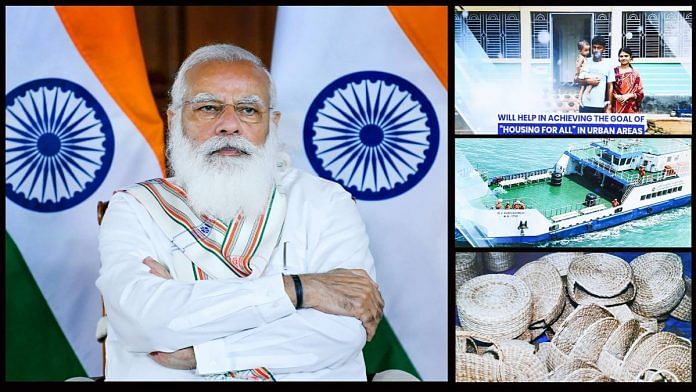New Delhi: With an eye to further strengthen India’s friendly ties with Bangladesh, Prime Minister Narendra Modi Tuesday virtually inaugurated the 1.9-km-long ‘Maitri Setu’ or the India-Bangladesh Friendship Bridge, built over Feni river that connects Sabroom district in south Tripura to Ramgarh in Bangladesh.
Inaugurating the bridge, Modi said it will not only boost friendly ties between the two neighbours but also prove to be a strong link of business. Bangladesh Prime Minister Sheikh Hasina in a video message said the bridge will usher a new chapter in relations between the two countries.
ThePrint explains what the Maitri bridge is about and why it is so important for India’s Northeast.
Fastest land route from Northeast to Chittagong port
Announced by Prime Minister Narendra Modi in 2015, the 1.9 km-double lane bridge, which also includes approach roads, was constructed at a cost of Rs 133 crore by the National Highways and Infrastructure Development Corporation Limited (NHIDCL), a government-owned company under the road transport and highways ministry.
Work on Maitri Setu was started in June 2017 and the project is fully funded by the central government.
The bridge connects Sabroom in Tripura to Ramgarh in Bangladesh. From Ramgarh, vehicles can either go by road to Chittagong port, which is approximately 80 km away. Alternatively, from Ramgarh, one can use the waterways to transport goods to Chittagong port.
The Maitri Setu will be the fastest land route to connect the landlocked Northeast region via Sabroom to Chittagong port.
Also read: India and Bangladesh discuss early completion of fencing along the borders
Gateway of Northeast
The Maitri bridge is rightly being called the “gateway of Northeast” as it will connect the landlocked region with Chittagong port in Bangladesh, unlocking the untapped markets of other east and south east economies.
According to a World Bank report released Tuesday, Indian trucks are not allowed to transit through Bangladesh as of now, which makes northeast India particularly isolated from the rest of the country. It is connected only through the 27-km-wide Siliguri corridor, also called the ‘chicken’s neck’. This, the report says, leads to long and costly routes.
“Goods from Agartala, for example, travel 1,600 kilometers through the Siliguri corridor to reach Kolkata Port instead of 450 kilometers through Bangladesh. If the border were open to Indian trucks, goods from Agartala would have to travel just 200 kilometers to the Chattogram Port in Bangladesh, and the transport costs to the port would be 80 percent lower,” the report estimates.
The bridge, which is just 80 km from Chittagong port, also makes Tripura capital Agartala one of the Indian cities located closest to an international sea port, unlocking untapped markets of other east and south east economies.
Part of Modi govt’s ‘Look East’ policy
Along with the Maitri bridge, Modi also laid the foundation stone of an Integrated Check Post (ICP) at Sabroom. The ICP aims to ensure seamless movement of goods and passengers between India and Bangladesh. The ICP project will be implemented by the Land Ports Authority of India at a cost of about Rs 232 crore.
This is among a slew of infrastructure projects announced by the Modi government since it came to power in 2014 and is in line with its ‘Look East’ policy, aimed at boosting trade and commerce with east and south-east Asian countries.
“This (the bridge) will give a big boost to trade and economy in the region,” A.K. Khushwaha, NHIDCL executive director posted in Tripura told ThePrint.
The World Bank report released Tuesday said an analysis done by them previously found that improving transport connectivity between the two countries could result in a 172 per cent increase in India’s exports to Bangladesh and a 297 per cent increase in Bangladesh’s exports to India.
Currently, bilateral trade accounts for a mere 1 per cent of India’s trade and only about 10 per cent of Bangladesh’s trade. Compared to this, in East Asian and Sub-Saharan African economies, intra-regional trade accounts for 50 per cent and 22 per cent of total trade, respectively. It is about 15–20 per cent less expensive for a company in India to trade with a company in Brazil or Germany than with a company in Bangladesh, the report points out.
(Edited by Manasa Mohan)
Also read: Political boundaries should not become physical barriers for trade, says Bangladesh PM






One has to ask why Congress government ignored the North East for so long to the detriment of the country’s economy? This was particularly relevant since, after 1971, the govt of Bangladesh could have been persuaded to work together for mutual upliftment.